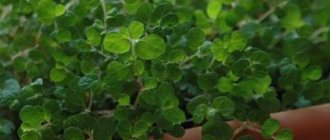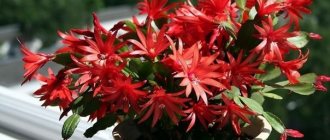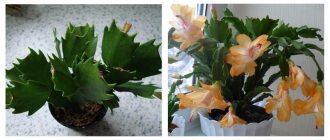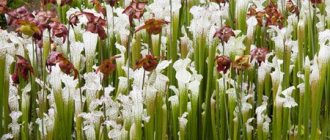Heather in a pot
Surely many people are familiar with the beautifully flowering heather plant that adorns meadows. But it can be successfully grown at home. On an insulated balcony, you can grow many varieties of heather in tubs or pots. You can also keep the plant in the room.
Heather in a pot at home - how to care?
In order for heather in a pot to develop well at home and delight you with its flowering, you need to follow certain rules for caring for it. They are as follows:
- maintaining optimal temperature conditions. During the spring and summer seasons, the flower should be kept at room temperature. But in autumn and winter it definitely needs to be kept cool. The best option would be if the room temperature is 6-10ºС;
- In order for heather in a pot to bloom luxuriantly at home, it needs to be provided with a bright color. The flower can be safely placed in a place where direct sunlight falls;
- An important condition for maintaining the plant is to follow the rules on how to water heather in a pot. During the continuation of the growing season, it is necessary to carry out abundant watering. During the winter season, the flower can be watered less often. But, at the same time, the volume of watering should be controlled to prevent the plant from becoming waterlogged. It is best to use distilled water. It should be at room temperature and exclude the presence of chlorine and lime in its composition;
- in spring and summer, heather leaves are sprayed;
- During the period of active growth (summer and autumn), it is necessary to feed the flower with mineral fertilizers. They are placed in the soil around the plant, avoiding contact with the leaves;
- monitor the acidity of the soil; for this, add spruce or gray bark;
- If the plant is kept on an open balcony, with the onset of frost it must be brought indoors.
Replanting heather
If the plant grows, it is replanted so that the root system feels free. At the same time, they ensure compliance with the following requirements:
- selection of soil mixture. It can be universal, with the addition of agroperlite or vermiculite. A good option would be to plant the flower in soil intended for azaleas;
- choosing the right container in which to plant the plant. The best option would be a fairly wide pot, small in depth. It should be selected taking into account the size of the heather root system.
Following the necessary recommendations for caring for heather in a pot will help you grow a beautiful and healthy plant.
Purchase at a flower shop
When purchasing this magnificent plant, you need to pay attention to the condition of the flowers; they should not fall off, and the branches should be flexible. The problem is that the bush can die even from short-term drying out of the soil during transportation, but this will not be noticeable in appearance, since it does not lose its decorative effect for several months.
Are you going to buy heather in a pot? It will survive at home if you carefully examine the condition of the bush before purchasing. If the plant is weak, it will quickly die if exposed to other conditions.
Proper planting and care of heather at home
Heather is a low-growing evergreen shrub, during the flowering period it very effectively forms a single carpet of white, red, purple and lilac flowers with a pleasant smell. If a forest bush is planted in the garden, then even during the first frost, flowers in the form of small bells continue to remain on the bush, pleasing the gardener’s eye.
This plant is used in the garden as a decoration for an alpine hill, border or rockery, as well as indoors in a pot. Despite the fact that heather is a fairly unpretentious plant, it is very demanding on light and soil quality, especially in indoor conditions. It will not bloom in too dark places, and if there is insufficient watering, it will wither; it also does not like frequent transplants, so it is recommended to immediately think about where it will be planted.
When planting heather in a home pot, you need to take into account that it is mainly an annual plant, so in order to preserve the bush, it must be trimmed and replanted once a year after flowering. In this article we will tell you how to care for shrubs at home and in the garden.
Frequently asked questions and answers
Gardeners who are just starting to grow heather find it difficult to cope with. It is necessary to know how and what to do at each stage of its growth, as well as other cultural features.
When does the plant bloom?
Heather flowering time is the end of August. Its great advantage is that even after the flowering period, the inflorescences do not fall off, but remain on the bush, so that the latter does not lose its decorative qualities for a very long time.
What to do after flowering?
At home, heather is often grown as an annual plant. In order for the bush to safely survive the winter and delight you with flowering again next year, appropriate feeding after flowering is necessary, as well as pruning. It is also important to keep the temperature low during the winter months.
What is the lifespan of a plant?
In the garden, heather can bloom for a long time - up to 5 years, while in nature its life is sometimes calculated in decades. But at home, this period is much shorter - 1 or even 2 years, if all the necessary conditions are created.
Why does heather dry out?
The heather dries out from lack of moisture. In dry seasons, you need to provide abundant watering, do not forget to also spray the plant, and humidify the air if possible. Also, the reason may lie in the soil, which has become slightly acidic. This requires appropriate feeding; for example, you can add acid along with water twice a year.
Despite the difficulties in planting and growing, heather remains one of the most interesting and useful plants. In addition to beautiful flowers that can be admired for a very long time, it is also used in medicine and cosmetology, and therefore is highly valued by gardeners.
To come in
Rules for planting heather flowers at home in the garden
For indoor maintenance, heather is planted in pots placed on a balcony or window (the south side with direct sunlight is destructive, but the east and west are ideal, so take into account the location), periodically ventilating the room.
Flowering heather bush
For planting, it is important to make sure that the plant has not dried out, since the flowering appearance of the flowers remains for a long time after they die. You also need to examine the roots for decay - there should be no gray coating on the ground.
For planting in a garden plot, the features are the same, and given that in nature the flower grows best on peat bogs, rocky soils and wastelands, we think over the location and prepare the appropriate soil.
Heather in nature
Necessary conditions for a flower
Heather lives shorter in an apartment than in the wild or garden - up to two years. In order for the plant to delight with flowers all this time, it is necessary to grow it correctly and then care for it.
Place and lighting
When choosing a room in which you plan to grow heather, you need to consider the following:
- it should be well ventilated;
- Heat harms the plant, so you need to prevent overheating (do not place it near heaters or radiators);
- a lot of diffused sunlight.
The ideal option is an insulated loggia, where the desired temperature will be maintained in winter. But avoid the south side and direct sunlight.
Temperature
High temperatures are detrimental to heather. Therefore, in winter it is enough for him to have +12-15 degrees, in summer – up to +25. When growing seedlings, try to keep the temperature around +18-20. Stuffiness is also contraindicated for the plant. But temporary removal to the street in spring and autumn on warm (but not hot!) days will have a good effect.
Indoor humidity
An abundance of moisture is important for heather; it will not grow well in rooms with dry air. To avoid this, gardeners advise spraying the bushes
Optimal soil composition and pot volume
For heather, a shallow and wide pot is best, but when planting the plant you need to focus on the roots. The depth of the container should exceed their length, and as the heather grows, it needs to be transplanted into a larger pot. Often heather is planted in long boxes, then you can put together a composition of several varieties.
Preparing the soil for planting
The soil must be acidic, this is one of the most important requirements , and the rest is not so critical, although it is better to give preference to a mixture of humus, peat and sand with the addition of sawdust or pine needles. Also, shortly before planting, it is recommended to additionally oxidize the soil with a special liquid: for 10 liters of water we take 100 grams of apple cider vinegar or citric acid, you can use 50 grams of electrolyte for batteries.
Read also: How to grow tomatoes in a greenhouse in winter as a business
Before planting, carefully straighten the root system of each bush by hand so that the roots look outward and not inward - if this is not done, the heather will not be able to take root and will die. When planting, the root collar of the bush should be slightly higher than the ground, and lay drainage at the bottom of each hole. When planting in a pot, you need to take a container 5-6 cm wider than the rhizome and be sure to leave the “native” lump of earth on the roots. The ideal time for planting is from mid-April to early June.
If you decide to plant a flower with seeds, then remember that under indoor conditions, heather will bloom within two years. The seeds are sown on the surface of the ground and placed in a greenhouse (covered with film). In two to three weeks, seedlings will appear, which are transplanted into open ground, preferably in the spring, but it is also possible at the end of September. Plants that have just reached three years of age are pruned, being careful not to cut off the branches at the root.
How to care after planting?
Heather is considered an unpretentious plant, but there are still some nuances:
- Loves fresh air, but does not tolerate drafts
- A houseplant needs to be fertilized more often than a garden plant. To do this, use Kemira Universal or a special fertilizer for azaleas. To feed, the product can be diluted in water or simply sprinkled on top of damp soil, sprinkled with a little mulch. The plant more often suffers from overfeeding the soil than from its poverty.
- Periodic mulching of the roots has a beneficial effect on the plant, since its roots are sometimes located above ground level. For this you can use bark, shavings and sawdust.
- Avoid watering with tap water, which contains too much lime and chlorine.
- Be sure to remove dried twigs and leaves
It is better to water once a week with rain or melt water ; you can also settle the water in containers before watering. Add acid to the water periodically. Watering is done at the root, trying not to get on the ground part - the plant can be affected by gray rot, while trying not to allow the top layer of soil, which mainly nourishes the bush, to dry out.
Heather bush in landscape design
Reproduction is carried out by seeds, dividing the bush and layering. To divide the bush in the spring, having dug up the bush, carefully divide it into two or three parts, preserving the earthen lump on the roots, and replant it in a new place. When propagating by layering, sprinkle large shoots with soil to a depth of 10 cm. Moisten the hill frequently so that roots germinate faster. When the rope takes root, cut it off from the mother bush and replant.
Pests and their control
Heather has several enemies that must be carefully fought:
- Aphids (we use Decis, Intravira)
- Spider mite (we fight with Aktara and Aktellika)
- Gray rot (use Fundazol, Topaz, Rovral for it)
- Powdery mildew and rust - spray the bushes with copper preparations
If you create favorable conditions, the heather will grow wildly and decorate your home (or site) with beautiful colors and an extraordinary aroma. And knowing that this plant does not require special care methods, it is perfect not only for experienced gardeners, but also for beginners.
Description of the plant
Heather is a perennial plant in the form of a bush. Its branches are covered with small flowers that look like bells. The color of the flowers can be varied: from white to dark purple. At home, two subspecies of common heather are most often grown: slender and wintering.
Source: Depositphotos Heather grown in a pot will be an excellent decoration for your home, balcony, or yard
Characteristic features of the plant:
- the bush reaches 40-50 cm in height;
- small leaves are located opposite on the branches;
- flowers are located at the tips of the shoots, 4 each;
- The length of the flowers differs among different varieties (from 5 mm to 2 cm).
For heather, it is important to choose the right soil - it should be acidic and peaty. Make sure the plant receives enough light and fresh air. Stuffiness in the room and direct sunlight negatively affect the condition of the bush. The best temperature for keeping it is 10-25 °C in summer and 12-15 °C in winter. In autumn and spring, when the temperature is moderate, take the heather out into the fresh air.
Read also: The best from Oktyabrina Ganichkina: we grow tomatoes
Description and properties of heather
The culture is classified as an evergreen creeping plant of the Heather family.
It grows on almost all continents, in our country it is widespread in European regions, in Siberian pine forests and peat bogs. Here is a botanical description of heather:
- A perennial shrub, similar in appearance to a low coniferous tree or juniper.
- The stems are medium-sized, up to half a meter high, dense, woody, resinous.
- The leaves are green, narrow, hard, wrapped in tubes, due to which they resemble pine needles. The foliage is numerous and densely grouped, forming a dense green background. There are about 70–80 thousand leaves on one bush.
- The flowering season occurs at the end of summer and lasts until the first cold weather. The buds are fragrant, grouped into lush racemose inflorescences. The color is discreet, different shades for different varieties.
- It bears fruit in seed pods; the seeds are very small and are carried far by the wind, allowing the crop to quickly multiply by self-sowing.
Heather is classified as an evergreen creeping plant of the Veresaceae family.
The plant is also in demand in folk medicine. Doctors prepare infusions and decoctions from it that have antibacterial and anti-inflammatory effects. The decoction helps dissolve kidney stones and improves well-being in cases of liver and gall bladder diseases. Tinctures are used for colds, gout and cystitis.
For many centuries it was considered a good folk sign to settle near heather thickets. It was said that where the heather lives, it will be comfortable for a person. Beekeepers value the crop as the latest honey plant, allowing bees to collect nectar even in late autumn.
Planting heather and care at home
Heather is propagated in three ways: by seeds, by dividing the bush and by cuttings. The best temperature for growing seedlings is 18-20 °C.
Sow seeds at any time of the year in a soil mixture of peat, coniferous soil and sand. Cover the container with grains with film or glass, ventilate and water the soil from time to time. Plant seedlings in permanent pots 8-10 months after germination.
Cut cuttings in early autumn from strong shoots without flowers, place in water until roots appear and root in a mixture of peat and sand.
After the bush has finished flowering, you can divide the roots for replanting. To do this, remove the plant from the pot and carefully divide it along with the soil into several parts. Plant the resulting seedlings in separate containers, water and fertilize with a special product.
Home care:
- do not allow the soil to dry out;
- water with settled water without chlorine;
- in the off-season, spray the branches with warm water;
- feed the soil with organic and mineral fertilizers, especially during the period of active growth;
- acidify the soil in the pot with spruce bark or sulfur;
- Every year, replant the plant into a larger pot, while trying not to damage the earthen ball.
After flowering, prune young shoots, maintaining the shape of the bushes. Such manipulations will stimulate the appearance of new branches and buds.
With proper care, heather will decorate your home for many years.
Reproduction methods
The process of generative cultivation of heather is already familiar to you, but if you have mature bushes, propagating it vegetatively is much easier:
- By cuttings. At the end of August, the tops are cut off from strong, non-flowering shoots and planted for rooting in pots with a peat-sand mixture (3:1). The cuttings are kept at a temperature of +15…+18 °C. Caring for them involves timely watering and feeding with a weak urea solution every 30–40 days. In the spring, with the onset of warmth, young bushes are planted in a permanent place.
- By layering. This is how heather reproduces in nature. To do this, bend several mature shoots of the lower tier to the ground, secure with a wire pin and sprinkle with a layer of peat 1–1.5 cm thick. After a year, the cuttings can be separated from the parent bush and replanted.
- By dividing the rhizome. In the last week of summer, an adult healthy bush is dug up and, without shaking off the soil from the roots, cut into several parts. Each division must have healthy roots and young basal shoots. After this, all old branches are removed, the cuts are sprinkled with crushed coal and new bushes are planted in separate holes.
Heather: care and reproduction at home
Heather belongs to the large heather family, which has more than 500 species. The homeland for most species is Africa. Heather is an evergreen shrub whose stems are dotted with small, bell-shaped flowers in various shades of lilac, lilac, white, pink and violet.
In nature, the most common heather is common, and slender heather and wintering heather are adapted to home conditions.
Slender heather is an evergreen shrub up to 40 cm high. The leaves are light green, up to 5 mm long. The flowers are pink-red in color, located at the ends of the side shoots, 4 pieces each. in everyone.
Wintering heather grows up to 50 cm in height, and its flowers are larger (up to 2 cm) and white.
Heather varieties
Common heather Dark Beauty – Calluna vulgaris Dark Beauty
Magnificent miniature plants with very bright, raspberry-pink flowers. The bushes do not exceed 20 cm in height. The leaves are dark green, small, and resemble scales. The flowering period begins at the end of summer and lasts until October, after which the flower stems should be trimmed.
Heather Annabel – Calluna Annabel
Tall plants reaching 45 – 60 cm in height. The flowers are lilac, densely covering the stems of plants, and are often used for cutting. Flowering occurs in September - October.
Common heather Aphrodite – Calluna vulgaris Aphrodite
An evergreen shrub with dark green leaves 40–60 cm high. The buds are soft pink and do not open completely. The flowering period is very long and when grown in open ground it lasts from August until serious frosts.
Common heather Amethyst – Calluna Amethyst
Medium-sized variety - shrubs grow up to 30 - 40 cm in height. The stems of the plant are densely covered with green, very small leaves. Flower shoots bear many bright, pink buds.
Home heather - height. About 60 cm.
Planting heather
If you decide to plant heather at home, keep in mind that it is cultivated at home as an annual plant.
You can continue to grow it: after the plant has flowered, you should feed the soil and then prune the bush, only then the plant will retain its attractive appearance next year.
Requirements for planting material
The root system of the plant must be closed, otherwise it will be damaged and the heather will die.
The shoots should be elastic and leafy, and there should be active vegetative buds at their ends.
Pot and soil requirements
Indoor heather species are very demanding on the soil.
Peaty or acidic sandy substrates are best suited for them. The pot should be deeper than the length of the roots.
Flower planting scheme
- We fill the bottom of the pot with the necessary substrate a few centimeters so that the root system can grow in the future;
- Then we very carefully move the planting material into the pot so that the root system remains intact;
- We fill up the missing soil without tamping it, otherwise you can damage the root system;
- Finally, you can water the plant and add a little more soil. The filling process must be repeated several times as necessary.
Varieties and types of heather
There are many varieties of common heather (Calluna vulgaris). All of them can be divided into several large groups:
1. Green-leaved group of heather. As the name implies, this group contains all varieties of crops that have green leaves:
- Allegro variety. The height of shrubs of this variety reaches 55-65 cm. It has many branches that form a dense crown, the diameter of which is 40-50 cm. The leaves have a dark green color and an oval shape. The flowering of this variety lasts from July to September. This type of heather is resistant to temperature fluctuations and is not afraid of frost.
- Variety Carmen. A very popular hybrid type of culture. It belongs to the low-growing varieties, since the height of the bush is no more than 35-45 cm. The leaves are small in size and have a dark green color. The length of the peduncle is about 8-12 cm. The Carmen variety is considered winter-hardy.
2. A group of heather blooming with white flowers:
- Alba variety. The height of the bush reaches 45 cm. It has a dense crown, with a diameter of up to 50-60 cm. The leaves have a soft green color. Flowers are grouped in large racemes.
- Alexander variety. The crown of the bushes of this variety has a rounded shape, the diameter of which is 45-55 cm. The bushes themselves grow quite low. Their height does not exceed 25-30 cm.
3. A group of heathers with silver leaves:
- Variety Silver Knight. Refers to low-growing varieties. The height of the bush is no more than 30-35 cm. It has a lush crown with a diameter of 50 cm. The bark on the shoots is brown. The flowers are grouped in small racemes, up to 18 cm long. It blooms with lilac or lilac flowers. This variety of crop is not afraid of frost, but if the temperature drops significantly, it should still be covered.
- Variety Peter Sparks. A tall type of heather. The bushes grow up to 65 cm. It has many shoots that form a dense oval-shaped crown. The length of the racemes is 25-30 cm. The flowers are dark pink and oval in shape.
4. A group of heather with golden leaves:
- Variety Andrew Proudley. One of the lowest growing varieties. The miniature bushes of this heather grow no more than 17 cm. However, the crown of these bushes is quite dense and is 23-27 cm in diameter. The leaves of the crop have a beautiful golden hue and orange tips.
- Variety Boskup. Bred in Holland. The height of the bush is 45 cm, the diameter of the crown is 50-55 cm. It blooms with lilac or pink flowers. The length of the brushes is 15 cm.
5. A group of heather blooming with double flowers:
- Variety Autumn Glow. The height of the bush is 25-27 cm, crown diameter is 40-45 cm. Double flowers are purple in color and bell-shaped.
- Variety Monica. A tall shrub, the height of which is 65 cm. It blooms with very large pink flowers.
6. Group of crops with unopening flowers. These include the following varieties:
- David Eason.
- Marlin.
- Romina.
- Fritz Kircher.
Rules for caring for heather in a pot
To ensure that the plant never ceases to delight you with its beauty, you need to know how to care for heather at home. To do this, just follow simple but important rules:
- Water the plant only with clean water, free of chlorine and lime, at room temperature;
- The substrate should not be overdried;
- Temperature in summer +18 -25°С, in winter - +8 -12°С;
- In the off-season, if possible, take it outside, while protecting the plant from drafts;
- During the spring-autumn period, it is necessary to spray the plant daily with warm water;
- Fertilize in a timely manner;
- Periodically acidify the soil with spruce bark or sulfur.
Read also: Is it possible to grow remontant raspberries in a greenhouse?
Rules for watering and spraying
Heather requires regular, but not excessive, watering to simply keep the soil moist. Spraying is necessary only in the warm season.
Feeding
Heather needs fertilizing every year. To do this, use complex mineral fertilizers, which can be bought in a special store. They need to be scattered around the plant, but it is very important not to touch the flowers and leaves; they can “burn” from a high concentration of fertilizers.
Features of flower transplantation
Heather is very difficult to transplant because it has an underdeveloped root system. It can cause damage to the roots, as well as mycorrhizal mycelium.
Therefore, heather for home use is usually purchased in special containers and replanted together with a lump of earth. Also, replanting can destroy heather if the new soil is not sufficiently acidified and turns out to be neutral or alkaline.
Trimming
After the end of the flowering period, the shrub is subjected to formative pruning, which inhibits its aging. In addition, thanks to this procedure, the splendor of the plant is preserved. Only the green part of the bush with leaves is trimmed. When carrying out this manipulation, branches are shortened at different levels to maintain the careless, natural appearance of the plant. If you treat the bush right down to the wood, it will die. For abundant flowering, heather branches are pinched at home.
How to propagate heather at home
Heather reproduces at home in three ways:
- seeds;
- cuttings;
- dividing the bush.
plant seeds at any time; no special conditions are required for this. The seeds are planted in bowls with a substrate that consists of one part coniferous soil, two parts peat soil and one part river sand. There is no need to “burrow” the seeds into the soil. The bowl must be covered with glass until shoots appear.
If all conditions are met, they should appear approximately 3-4 weeks after sowing. Humidity should be kept high during the first week, and then the sprouts should be misted about 4-5 times a month. In the summer, be sure to take them out into the fresh air.
You can plant them in pots after 8-10 months.
Cuttings for propagation are cut at the end of summer. For this purpose, it is necessary to use non-flowering, strong shoots. Cuttings should be rooted in separate pots. A loose soil mixture of equal proportions of peat and sand, poor in nutrients, is suitable, and it must be constantly moistened. Rooting occurs at a temperature of +15-20 °C.
However, the most reliable, simple and fastest way to propagate heather is to divide the rhizomes into two parts. This procedure must be carried out after flowering. The plant needs to be removed from the pot and divided into parts.
In any case, it will not be possible to avoid damage to the root system, but still try to do this as delicately as possible. Then both parts are planted in pots as independent plants, watered abundantly and always fed.
Growing heather: video
Heather slender
In the natural environment, the lifespan of a plant is several decades; in a garden or alpine hill, it is reduced to five years. The home atmosphere is unusual for the plant; a two-year flowering period can be guaranteed.
Growing heather
they begin with choosing a planting site and preparing the soil; its composition should include peat, coniferous soil and river sand. Carefully inspect the planting material: the shoots are required to be elastic and have vegetative buds at the tips. Annual seedlings take root well. In large ones, plants should be placed at intervals of 25-30 cm; the root collar should not be deepened into the ground.
Growing heather on a home windowsill is a fascinating, but labor-intensive activity. You will have to constantly ventilate the room and spray the flower generously when it gets warm. For the pot, it is advisable to choose the most illuminated area; in the shade the plant will begin to hurt. Recommended temperature range is +18…+25°С for summer and +10…+12°С for winter.
Heather swollen
When growing heather, you need to remember its special sensitivity to lime and chlorine. you will have to settle or collect rain and melt.
When the plant fades, it is removed from the pot, the rhizome is divided into several parts and planted in new containers. Growing seedlings from seeds will take much longer. Low ceramic containers are filled mainly with peat soil, adding a little sand and pine needles. The seeds are left on the surface of the soil and the entire structure is covered with glass on top. The first week there is abundant moistening, then only periodic light spraying. The first shoots will appear in about a month, and the maturation period will last almost a year.
Growing heather requires cool conditions
In summer, you should take the container with the plants out into the open air so that they grow stronger and harden.
Takes less time than caring for seedlings. The cuttings are laid out in pots filled with a mixture of sand and peat in equal proportions. The appearance of leaves and the full formation of the root system serves as a signal for replanting the plant to a permanent location. When growing heather, you can use hydrogel; it prevents the soil from becoming too dry.
- Common heather (lat. Calluna vulgaris) is a bright autumn plant, playing with all shades of purple, maybe...
At the beginning of autumn, pots of heather appear on sale in garden centers - one of the most beautiful and popular autumn-flowering plants used to decorate balconies, windows and terraces.
In a natural environment, the plant can grow for up to 10-15 years; in the garden, its lifespan is 3-4 years; indoors, without proper care, the flower rarely survives the winter.
That is why it is most often used as a seasonal ornamental plant, and in order to prolong the life of heather at home, careful care and specific maintenance conditions are required, without which the flowering bush quickly dries out.
But even after death, the wasteland flower does not lose its decorative effect and is often used in various floral compositions.
Flower diseases and pests
Diseases and pests affect the heather flower much less often at home than when grown outdoors, but there is still a risk, mainly associated with excess soil moisture.
The main pests that can affect the plant are scale insects . Morning spraying with soapy water is used as treatment.
When water stagnates in the roots, the plant is affected by gray rot . The first signs are a gray coating on the shoots, falling leaves, and partial death of young shoots.
When they appear, it is urgent to treat the plant with antifungal drugs. Treatment is carried out in 2-3 doses with an interval of 6-10 days. For prevention, early spring or late autumn is best.
If the leaves turn brown and the tops of young shoots begin to wilt, this is a sign that you have overdid it with fertilizers .
The plant can also be affected by powdery mildew . Because of this disease, young shoots begin to dry out and the leaves become covered with a grayish coating. For treatment, as in the case of gray rot, you need to use antifungal drugs.
Viral diseases are especially dangerous . Symptoms: noticeable deformation of flowers and shoots, their unusual color.
In this case, the plant urgently needs to be dug up and burned, since there are no effective treatments for these diseases.











